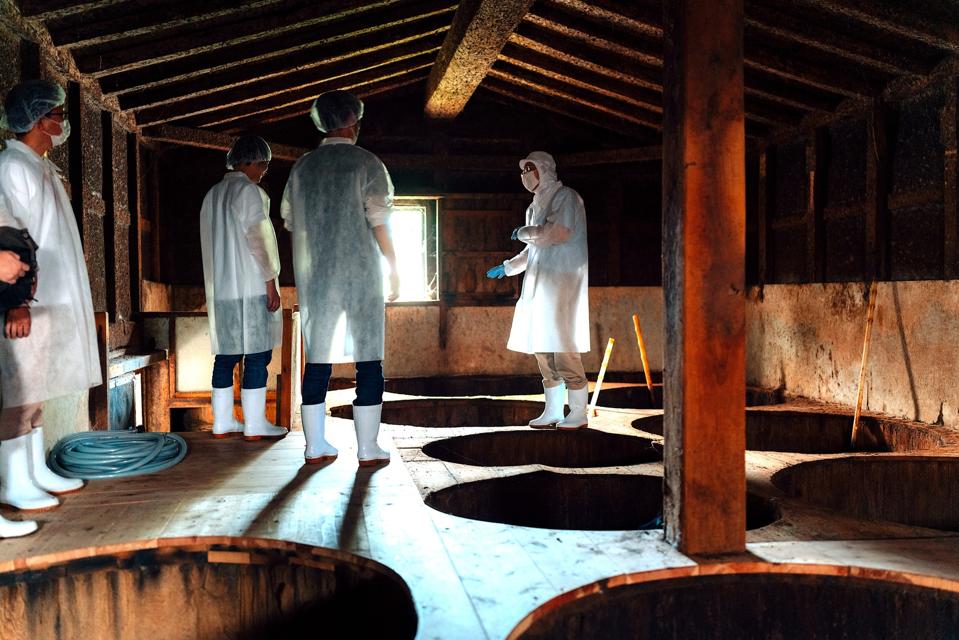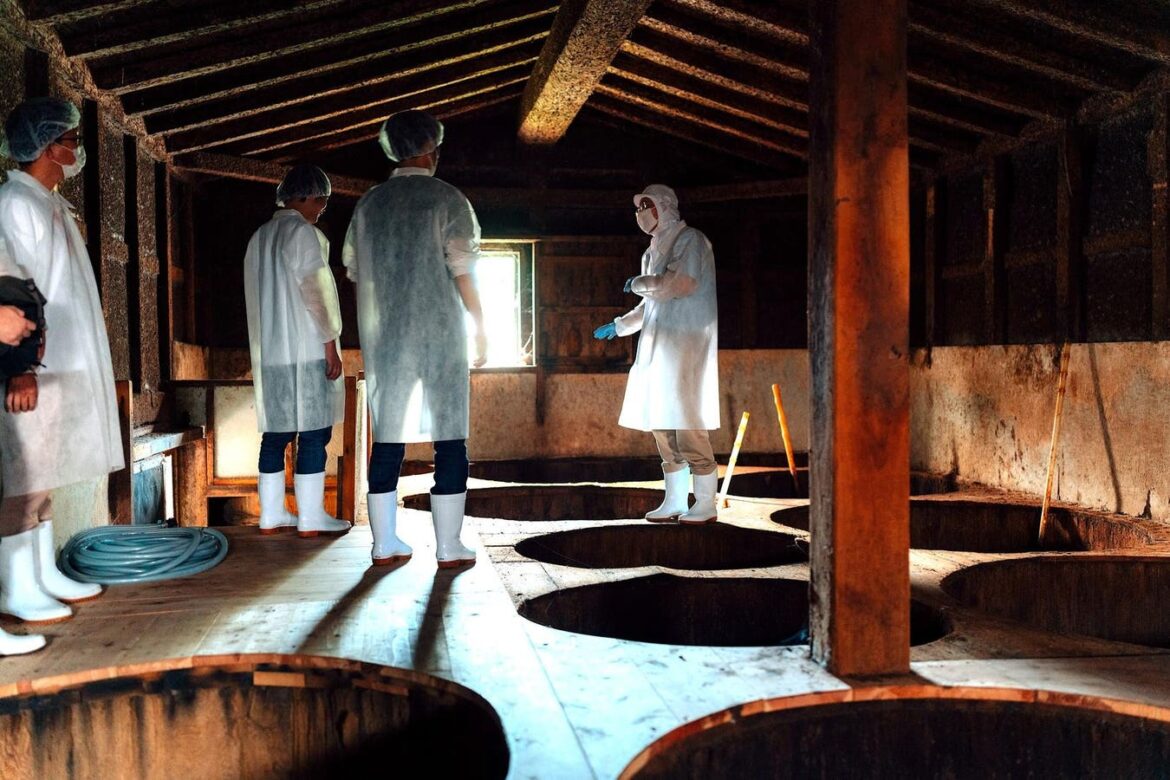
A traditional soy sauce brewery in Japan that Sato’s tour visited.
Takashi Sato
Fermentation has become a keyword these days, not just among chefs but the general public.
There are multiple reasons for the surge in its popularity, such as the health benefits of rich probiotics in fermented foods and culinary interests.
A good example of the latter is represented by the book The Noma Guide to Fermentation: Including koji, kombuchas, shoyus, misos, vinegars, garums, lacto-ferments, and black fruits and vegetables (Foundations of Flavor) . Written by chef René Redzepi of Noma in Denmark, one of the best restaurants in the world, it has become a textbook for those who are interested in fermented food production.
One of Redzepi’s favorite ingredients is koji, which is a type of beneficial mold used to produce a majority of Japanese fermented food products, such as soy sauce, miso and sake.
“Koji fermentation can effectively deepen and expand the range of flavors in ingredients. But its use doesn’t have to be limited to traditional Japanese products, as chef Redzepi has shown to the world,” says Takashi Sato, president of the soy sauce maker San-J International in Virginia, the U.S.
For instance, a flexible, modern application of koji fermentation is Mushroom Garum, which Sato developed with the team at Noma. Garum, the ancient Roman-style fish sauce, is updated by using koji, kombu and mushrooms to boost its umami further. He has also developed a corn soy sauce with the team at the Michelin 3-star restaurant Eleven Madison Park.
Artisanal Fermentation Industries At Risk
Sato is the 8th generation family member of Sanjirushi Jozo in Mie Prefecture, which was founded in 1804. San-J is one of the most familiar soy sauce brands in the U.S. and its products are distributed through online and approximately 18,000 retailers, including Whole Foods Market. His soy sauce has over 30% market share of the natural soy sauce category and two-digit growth annually in the U.S.
Takashi Sato, president of San-J International.
Takashi Sato
His successful soy sauce business keeps him more than busy, but Sato has also been actively promoting the precious tradition of Japanese fermentation.
“The global community is increasingly curious about koji-fermented food, but there is not enough information in English. And importantly, the Japanese traditional fermented food industries are in a sharp decline. We have to connect the two worlds urgently to keep the precious tradition of fermentation alive,” he says.
“In 1955, there were 6,000 soy sauce manufacturers in Japan, but the number is down to around 1,000 now. Many of them are family businesses that have carried valuable traditions for centuries and I am seriously concerned about losing them before too long.”
The same situations are found in other fermentation industries. For example, there were around 3,500 Japanese sake breweries in 1970, but the number is down to around 1,000 now.
The reasons for the rapid decline in these industries include the shortage of younger generations that are willing to take over the labor-intensive family businesses and the increasing market competition against non-traditional food products.
Educating About Koji Fermentation: Tours, Factory Visits And Beyond
To revitalize the traditional businesses and satisfy the global need for learning about fermentation, Sato has already worked on many projects.
First, he organized a tour in 2022. He took American food professionals to Japan and visited artisanal fermented food producers. It was a success—the participants were able to deepen their knowledge of Japanese fermentation culture. The effectiveness of the tour didn’t stay only with the participants. For example, some of the chefs who joined the tours came back to the U.S. and educated their communities at workshops and dinner events.
Participants of Sato’s fermentation tour exchanged in-depth conversations with traditional producers.
Takashi Sato
The three-day tour has become a popular annual event. The number of participants in the past tours ranged from six to 20. Each participant paid $2,500, exclusive of airfare, but the slots were sold out quickly. This year’s tour is scheduled in October and the details will be available on Sato’s Instagram page.
Sato also holds an annual open house at his soy sauce factory in Virginia, where people can visit the inside of the factory to learn the process of fermentation.
“Japan is too far for most of us to visit. At the open house, whoever is interested in fermentation can see, smell and taste what fermentation is about. We have seen diverse visitors, including families with young children,” he says. This year’s open house will be on September 20.
Visitors can enjoy hands-on experiences at San-J’s Open House.
Takashi Sato / Dave Parrish
Sato is also trying to bring small fermentation businesses from Japan to the U.S. To do so, he generously opened San-J’s distribution channels to them.
“It is almost impossible for them to enter the U.S. market, due to the language barrier and the highly competitive distribution channels. But we are already in major American retailers and we can help them by acting as their middleman,” he says.
The companies that have successfully established the U.S. distribution with Sato include Kimono Mom, Oryzae, and Tokyobal.
Sato’s various activities have caught the attention of notable institutions like The Smithsonian Associates, Cornell University and Georgetown University, where he gave lectures on fermentation.
“But this is not enough. We need to build a path to educate people in a much longer term,” says Sato.
That is why he is working on setting up a program of fermentation at culinary schools. “By teaching future chefs, we can more widely and effectively inspire the world about the value of fermentation.” In response, a school in Arkansas is already considering a new curriculum focusing on fermentation.
“Fermented food is healthy and it offers wonderful flavor complexity. Fermentation is sustainable, because it is fundamentally a method of preservation to prevent food waste,” he says.
“Loss of traditions happens, but we can stop it. Japanese fermentation is something we need to preserve, not just for the Japanese but for future generations in the whole world,” says Sato.
Koji fermentation is a foundation of Japanese food culture.
Getty Images


AloJapan.com